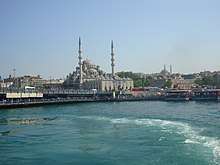Tirimüjgan Kadın
Tirimüjgan Kadın[1] (died 3 October 1852; Ottoman Turkish: تیرمژکان قادین) was the second wife of Sultan Abdulmejid I, and the mother of Sultan Abdul Hamid II of the Ottoman Empire.
| Tirimüjgan Kadın | |||||
|---|---|---|---|---|---|
 The burial place of Tirimüjgan Kadın is located inside The Cedid Havatin outbuilding of the mausoleum of Turhan Sultan, in New Mosque at Eminönü in Istanbul. | |||||
| Died | 3 October 1852 Old Feriye Palace, Constantinople, Ottoman Empire (present day Istanbul, Turkey) | ||||
| Burial | Cedid Havatin Türbe, New Mosque, Istanbul | ||||
| Spouse | Abdulmejid I | ||||
| Issue |
| ||||
| |||||
| House | Ottoman (by marriage) | ||||
| Father | Bekhan Bey | ||||
| Mother | Almaş Hanım | ||||
| Religion | Sunni Islam | ||||
Early life
According to some sources, Tirimüjgan Kadın was Armenian.[2]According to others Tirimüjgan Kadın was born in North Caucasus.[3] She belonged to the Shapsug tribe of the Circassians.[4] Her father was Bekhan Bey, and her mother was Almaş Hanım.[3] Despite her well-documented origins, Abdul Hamid's personal enemies falsely claimed that she was the daughter of an Armenian musician, originally named Çandır. Although Abdulmejid never took. Greek or Armenian consort. [4][5]
She had been brought to Istanbul as a young child, where her father entrusted her to the imperial harem. Here her name according to the custom of the Ottoman court was changed to Tirimüjgan.[3]
Prior to her marriage with Abdulmejid, she served as a kalfa in the imperial harem. She was then promoted to the position of Kadın (woman) of the Sultan.[4] In her memoirs, her granddaughter Hamide Ayşe Sultan, the daughter of Sultan Abdul Hamid II, depicts Tirimüjgan as having "green eyes and long, dark blond hair, pale skin of translucent white colour, thin waist, slender body structure, and very good-looking hands and feet."[6]
Marriage
Tirimüjgan married Abdulmejid in 1839. She was given the title of "Second Consort".[4] Charles White, who visited Istanbul in 1843, wrote about her that she had the reputation of great beauty and accomplishments, and of writing tolerable poetry.[7]
Tirimüjgan gave birth to two princes and one princess. Her first child was Naime Sultan, who died of smallpox at the age of two and a half in March 1843. Abdul Hamid was her second child, while her third was Şehzade Mehmed Abid, who died in May 1848 around the age of one month. Abdul Hamid named one of his daughters, Naime Sultan and one of his sons, Şehzade Mehmed Abid after these siblings of his.[8]
Having lost a daughter, Tirimüjgan devoted herself to her son, Abdul Hamid, and during her illness, she did everything she could to ensure his happiness. He would go every day to Beylerbeyi Palace to see her, then return to Dolmabahçe Palace.[8]
Among all her fellow consorts, she felt the closest to Perestu Kadın and always held her in high regard.[9] After her death Abdul Hamid was adopted by Perestu Kadın. Who also had been the adoptive mother of Cemile Sultan.
Nergisnihal Hanım was one of the closest servant to Tirimüjgan, Tirimüjgan appointed Nergisnihal in the service of her infant daughter Naime, and after the death of Naime, she appointed her in the service of Abdul Hamid. [10] Before Tirimüjgan Kadın died she imparted to Nergisnihal “I entrust my son to you, Do not abandon him, so long as you live, sleep outside of his room”. After her death, she did the same as Tirimüjgan bequeathed her, and never left Abdul Hamid, she died in 1892. [10]
Death
Tirimüjgan died on 3 October 1852 in the Old Feriye Palace, and was buried in the mausoleum of new ladies in New Mosque, Istanbul.[11] In 1887, her son Abdul Hamid constructed a Mosque in Rhodes in the memory of her. [12]
Issue
Together with Abdulmejid, Tirimüjgan had three children:
- Naime Sultan (Topkapı Palace, 11 October 1840 [13] - 30 April 1843, buried in Mustafa III Mausoleum, Laleli Mosque); [14]
- Sultan Abdul Hamid II (Topkapı Palace, 21 September 1842 - Beylerbeyi Palace, 10 February 1918, buried in Mahmud II Mausoleum, Divanyolu), married thirteen times and had seventeen children;
- Şehzade Mehmed Abid (Old Çırağan Palace, 22 April 1848 - 7 May 1848, buried in New Mosque Mausoleum); [11]
See also
- List of consorts of the Ottoman Sultans
- List of mothers of the Ottoman sultans
References
- Freely, John – Inside the Seraglio, Chapter 15: On the Shores of the Bosphorus, published 1999, Istanbul)
- John Freely (1 July 2001). Inside the Seraglio: private lives of the sultans in Istanbul. Penguin.
- Açba 2007, p. 31.
- Uluçay 2011, p. 204.
- Brookes 2010, p. 128.
- Brookes 2010, p. 127.
- Charles White (1846). Three years in Constantinople; or, Domestic manners of the Turks in 1844. London, H. Colburn. pp. 9.
- Brookes 2010, p. 133.
- Brookes 2010, p. 134.
- Brookes 2010, p. 135.
- Uluçay 2011, p. 205.
- Açba 2007, p. 32.
- Uluçay 2011, p. 218.
- Adra, Jamil (2005). Genealogy of the Imperial Ottoman Family 2005. pp. 8.
Sources
- Uluçay, M. Çağatay (2011). Padişahların kadınları ve kızları. Ötüken. ISBN 978-9-754-37840-5.
- Açba, Leyla (2004). Bir Çerkes prensesinin harem hatıraları. L & M. ISBN 978-9-756-49131-7.
- Açba, Harun (2007). Kadın efendiler: 1839-1924. Profil. ISBN 978-9-759-96109-1.
- Sakaoğlu, Necdet (2008). Bu Mülkün Kadın Sultanları: Vâlide Sultanlar, Hâtunlar, Hasekiler, Kandınefendiler, Sultanefendiler. Oğlak Yayıncılık. ISBN 978-6-051-71079-2.
- Brookes, Douglas Scott (2010). The Concubine, the Princess, and the Teacher: Voices from the Ottoman Harem. University of Texas Press. ISBN 978-0-292-78335-5.
_p259_Sultan_Abdul_Hamid_II.jpg)
